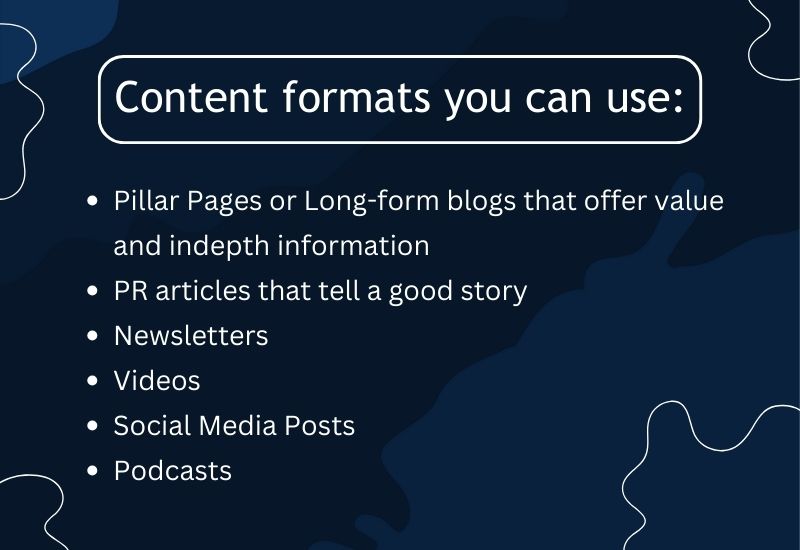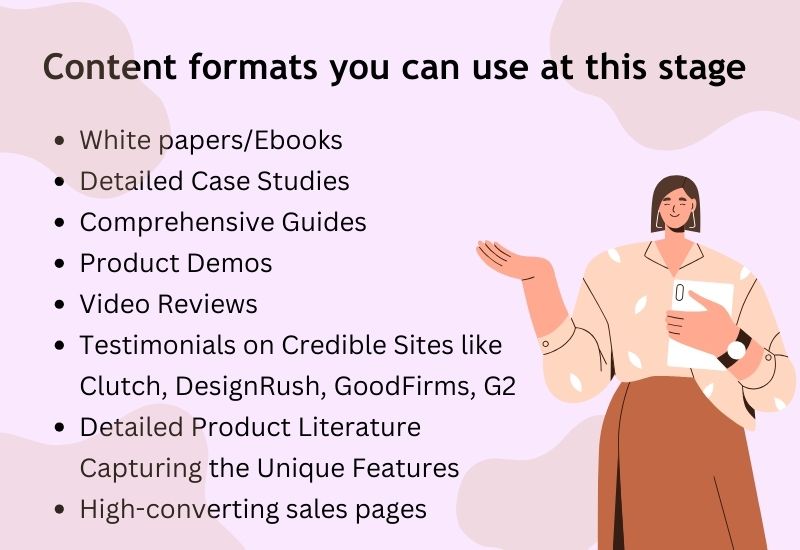Is content marketing going to be dead? Well, I have been hearing this question time and again and hence thought we should dedicate a post to answer this question.
My answer is – NO content marketing is not going to be dead, this year or even in the near future.
That is because content marketing is still one of the best ways to grow your business organically. It will help you generate brand visibility, build trust with your audience, get traffic to your website and convert them into leads.
The only thing is – you cannot do content marketing in the old way.
That is because things have changed and are still changing. And hence your content also needs to change. You cannot keep doing content marketing the way you were till now and expect to get results.
Here are the top reasons why we need to think about content differently–
– Ai has changed the world and the way content is getting created. You need to understand how to AI-proof your content.
– Google is also soon going to be rolling out SGE, which is going to be sending SEO back into the Wild West. Expect a roller-coaster year in search.
– The way people buy, both in B2B and B2C, has changed. You need to know what to do about that.
When we do content marketing today, we need to keep in mind the above things.
If you are startup, brand, small business, marketer, solopreneur wanting to get the best out of content marketing, here are few things to keep in mind.
So what are the top things you can do as a content marketers to future-proof our content from the changes that are coming our way.
8 top things we need to change about content marketing
If you want your content to perform and get you results, help your business and brand grow, you need to think about content the right way. Here are the top 8 ways to do content marketing in the times ahead.
1. We need to change the way we think about content and traffic, and stop creating content blindly.
Firstly, we need to really understand why do we need content and how are we going to produce that content?
Traditionally, the way most businesses have been approaching content creation or content marketing is
Let’s create more content = Try to rank these content pieces = Get traffic no matter what kind that is = get a few converts from there.
Well I am not saying this does not work, but here is the problem with that. When you create content for any kind of keyword related to your industry that has the potential to drive in loads of traffic to your website, you are just prepping up to get traffic.
Also, most of this “awareness” content created for ranking purposes is typically lacking in quality, depth and actual value. Fluff content and volume content becomes the name of the game. And this is still happening.
But how much of the traffic that is landing on your website through this kind of content is actually leading to sales and conversions? It will be very very less.
So what is needed is a different approach to traffic. Content cannot be created to just get more traffic, or any keyword that has very high traffic. Content needs to be created to get more relevant traffic.
Yes, brand visibility is ofcourse important and you still need to rank those top of the funnel keywords, but you cannot just pump in large number of poor and thin quality content, AI generated stuff, to get more traffic.
As search rankings get more and more competitive, and Search Generative Experience kicks in 2024, getting traffic might get harder than ever.
So what should you do – well for starters, think differently about the kind of traffic you want. You do not want to go the “more content is to more traffic way”.
Traffic is in most cases, just a vanity metric for most marketing teams. Look into how much of the traffic is getting converted, and what kind of topic is actually getting you more sales. Create value for your customer. Make it easier for them to buy from you. Answer the questions they want to know. That’s it.
Create value content. Throw out the fluff. This brings me to point number two.
2. Understand search intent and the stage your buyer is in and create content accordingly.
How can you find out what your buyer has set out to search for and what is the intent behind that search?
Well the best way to find is to look at the marketing funnel.
If you want to know the search intent of your buyer through the marketing funnel, then first understand what are the various stages of the marketing funnel.
Stage 1: Top of the Funnel (Awareness Stage)
Every buyer begins their search journey with a need, which basically leads them to seek solutions. They start searching online to get answers that will help them solve that question/pain point. So in this phase, your buyer
- Has a question or a pain point
- Is looking for a solution but does not know what it is
- May or may have answer in his mind, but he is still searching for answers.
Search intent at this stage: Informational.
What kind of content is needed: Your prospect is looking for content that is going to help him learn something and solve the above things. Your content needs to be educational and centre around –
- How
- Why
- What
- Where
- Guide
- Tips
- Who

Stage 2: Middle of the Funnel (Interest/Exploration + Desire/Evaluation)
In this stage, there is a lot of activity going on. The prospect is actively searching for different answers, getting answers, looking for more answers. S/he is exploring, getting interested in something, leaving it to see more options, then slowly and slowly narrowing down on what they desire to buy.
Search intent at this stage: Explore and Evaluate and Narrow Down.
What kind of content is needed: The prospect wants content that will help him decide on the right service/product, or atleast narrow down to one or a few. He needs content that can convince him that he is making the right choice.

Stage 3: Bottom of the Funnel (Action/Purchase)
With a clear preference established, consumers are ready to make a purchase. This is the moment for businesses to seize, encouraging consumers to convert their interest into action.
Search intent at this stage: Ready to buy. Just needs a little nudge to make the final purchase.
What kind of content is needed: At this stage, every piece of content needs to be transactional, pushing the client to make a purchase. Think of which part of your service or product feature can sway the customer to make a purchase, what can you offer that your competitor does not have, what better deal you can give that can make a difference. Remember this content has to be hardcore convincing. Generic stuff will not work here.
Content formats you can use
- Detailed Product and Service Pages Focusses on How the User Benefits
- Brand Comparison Literature
- Demo and Discount Pages
- Emailers with Deals
- Reviews
Once you understand the search intent of the buyer at every stage of the funnel, it becomes easier to find the right keywords, and the right topics matching that intent, and creating the right kind of content format.
Note: Just creating content for the sake it, without understanding which part of the funnel you are serving, is just going to lead to resource wastage and zero conversions.
So focus on having a plan that will lead to better content, better conversions.
3. Approach content marketing like an eco-system. Think beyond Google search.
Let us understand this.
Your buyer is not going to buy something from you just by reading one blog, or seeing one ad.
He will be moving from one platform to another, one device to another, and one content format to another before he makes a final decision. This is more true, if he is a B2B buyer.
Basically, a prospect converting by just reading one or two blog posts or one social media post, or reading one newsletter, is extremely rare.
Hence, it’s important we approaching content marketing as an eco-system. In this, different pieces of content (in different formats), published on different platforms, work together in unison to impact the prospect’s decision-making.
For example –
Step 1 – A user finds a blog/ebook/pillar page etc written by your business and clicks to read it.
Step 2 – He scans your website, reads the content, fills the newsletter subscription, closes it.
Step 3 – A few days later, he visits your social media profile, checks it and closes again. A newsletter from you hits his inbox, renewing the interaction with your brand.
Step 4 – A few days later, he sees a Google ad, goes to the website and finally converts as a lead.
This is the eco-system that will work.
Takeway and Tip: Do not just invest in building content for one channel, or platform. If you are building content for your website, do not stop there. Build content for the social media channel that most works for your business, publish that newsletter or send out that emailer, create content for your podcast. You got the flow right.
Think of content as an ecosystem build across different channels, and formats. Make it work together.
4. Create the sort of content that AI can’t
If you are one of those websites that has to create huge dumps of content to earn traffic, low quality stuff that is peppered with keywords, go ahead and use AI. But if you are looking for conversions, don’t do it.
AI content is robotic, generic and BORING. And trust me, we are all headed towards an overload that kind of content. Your audience will most definitely be wanting to read something that carries value, not stuff that has been created by machines, reads perfect grammatically, but makes hardly any sense.
Also, if Google continuously sees people jumping on your blog and bouncing off, they will start to down-rank your content.
Takeway: If you want to AI-proof your content, you need to think of content that is nuanced, personalised, written by subject matter experts, gives the stamp of authority, creates trust.
Use AI to brainstorm ideas, create structure and draw ideas, and get a gap analysis done. Take all these input and create your own content, personalise it, add thought leadership content, offer value.
With Search Generative AI, coming into the picture, people are already going to the Ai tools to get their answers. If you are churning out the same garbage, that why should people read you anyway.
5. Add more short-form content in your content strategy
If we need to create content that will perform, we need to understand how Google works. The search giant has already announced its Ai-powered search vision – to help users get the information they want in the quickest and most efficient way.
And this is where short form content comes in – what Google is referring as “snackable, visual, human and personal”.
Let us remember that not every user which comes to Google to search something, wants to read an elaborate article or a guide to get the answer. Also, you need to think how the user is searching on the mobile. Mobile viewing works beautifully with short content and recent research is showing that short form content is working great in terms of engagement.
So if you want to stay relevant, your content SEO strategy needs to include short and long form content. Striking the right balance is the key.
6. Lean on long-tail query-format content
If you have been publishing only 2000-words-plus blogs, and focussing on high volume short-tail keywords, it’s time to redo your content strategy.
As Google moves more and more to AI to deliver search queries, we need to understand how to create content that will be more relevant.
So start focussing more on long-tail keywords while creating content. Start creating content that answers long-tail queries, and follow up queries, that are informational, conversational, and commercial.
Since the intent of SGE is to provide informative answers that precisely solve queries of users (where can I find a playschool near me for a nine-year-old), and will also cater to follow up questions (where can I find a playschool near me for a nine-year-old that is also vegan), it would be a wise strategy to focus on –
- long-tail search queries,
- follow-up queries,
- and conversational content.
Information, commercial and transactional long-tail queries should occupy a pretty large place in your content strategy.
7. Create more videos and audios
There are two formats of content that you must invest in 2024 – audio and video content. Why? Because AI does not lend well to these two formats. If you want to prepare for the Ai world, then make sure you invest in formats that have their own character – video and audio.
These are likely to have greater impact in the coming year and years, since these are content formats that capture human expertise, skills, humour, wit and emotions. Hence they will impact your audience, which is soon going to be fed up with generative AI content.
Also short-form video content is expected to perform really well in the coming years. This can form an alternative way of driving traffic to your website apart from Google Search.
8. Don’t forget to repurpose your content and go beyond search.
One of the most important things to do, that many of us do not do, is repurpose each piece of content the best you can. Content repurposing is one of the best things you can do to get additional traffic from various places without investing in new content.
Every time you are repurposing your content, you are squeezing a little more benefit out of that piece. This benefit comes in the form of traffic, more brand visibility, and sometimes even conversion.
Here are some examples –
- Long-form Blog – turn into ebook – turn into emailer – turn into social media posts – turn into videos – turn into podcasts
- Record a webinar podcast – use the video for Youtube – create short videos from the same video to post for social media or long-format posts – use the same video for an audio podcast – use the content to create a blog – use the content to generate a newsletter.
By repurposing your content on various other channels, you are opening up newer ways for your audience to reach you. Someone finds you through a video, someone through your newsletter, someone through a podcast, and someone through LinkedIn. It’s always wise to not depend on a single channel for traffic and lead acquisition – and this remains valid for Google search as well.
Wrapping it up
Wrapping it up, content marketing is not dead. But you cannot be doing the way you did it 10 years ago, or even 5 years ago. If you are not adapting to the game, you will be losing out on a chunk of opportunities and losing relevance.
The content marketing of today and the near future is going to be heavily influenced and impacted by AI, it is going to buyer-centric and it is going to be personalised and human. How will you do it? Well, just follow the 8 ways of doing content marketing that we explained above and start implementing them.
For any other questions, feel free to reach out to us.





